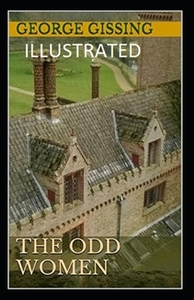Take a photo of a barcode or cover
reflective
slow-paced
Plot or Character Driven:
A mix
Strong character development:
Complicated
Loveable characters:
Complicated
Diverse cast of characters:
No
Flaws of characters a main focus:
Yes
"'But--' the girl hesitated--'don't you approve of any one marrying?'
'Oh, I'm not so severe! But do you know that there are half a million
more women than men in this happy country of ours?'
'Half a million!'
Her naive alarm again excited Rhoda to laughter.
'Something like that, they say. So many odd women--no making a pair
with them. The pessimists call them useless, lost, futile lives.""
Rhoda Nunn to Monica Madden
ch. 4
Complex examination and critique of social mores, women's rights, the plight of the 'odd woman', the equality of the sexes, marriage. Other themes are jealousy, and freedom of both men and women. Fascinating and at times enraging. Published in 1893, The Odd Women is a most blatantly feminist novel written, surprisingly, by a man. Depicts all the pros and cons of the transition during the New Woman movement. This is not a happily ever after romance. It is a tragedy.
'Oh, I'm not so severe! But do you know that there are half a million
more women than men in this happy country of ours?'
'Half a million!'
Her naive alarm again excited Rhoda to laughter.
'Something like that, they say. So many odd women--no making a pair
with them. The pessimists call them useless, lost, futile lives.""
Rhoda Nunn to Monica Madden
ch. 4
Complex examination and critique of social mores, women's rights, the plight of the 'odd woman', the equality of the sexes, marriage. Other themes are jealousy, and freedom of both men and women. Fascinating and at times enraging. Published in 1893, The Odd Women is a most blatantly feminist novel written, surprisingly, by a man. Depicts all the pros and cons of the transition during the New Woman movement. This is not a happily ever after romance. It is a tragedy.
challenging
dark
reflective
sad
slow-paced
Plot or Character Driven:
A mix
Strong character development:
Complicated
Loveable characters:
No
Diverse cast of characters:
No
Flaws of characters a main focus:
Yes
Unenviable reputation: George Gissing’s Odd Women are rather fab, even if they don’t quite deliver on their promise of emancipation and liberated behaviour to its logical conclusion - restrained probably by the corsets out of which Virginia slips to sip gin (two parts to one of water, the minx). She’s my favourite, though Rhoda, who despises romantic novels with their “sickening sameness of vulgarity” is also good value, as is Mrs Cosgrove, who loathes the institution of marriage and finds “a scandalous divorce case is a delight.” They caused a stir in their day, and gave their creator infamy, and whilst they don’t eschew men entirely and run off to a women only space in the South American jungle, it’s very much hinted that’s what they’d like. A classic for moderns.
dark
reflective
sad
slow-paced
Plot or Character Driven:
Character
Strong character development:
Yes
Loveable characters:
No
Diverse cast of characters:
No
Flaws of characters a main focus:
Yes
I loved this book! It asks the question, what if Jane Eyre had never met Rochester, or inherited money? Women in the 19th century had very few options, and were often stuck in dead-end jobs on the verge of poverty. This is an excellent work of Victorian social realism, centered on a group of female characters on different rungs of the London social-class ladder. Recommended!
the title of this book should've been "too bad, so sad", bc damn did everyone struggle in this book. had to read for my last history assignment and boy am i glad that is over. next time i wanna feel depressed about being a woman, i'll pick up this handy dandy novel. thanks george! #ripmonica
It's particularly interesting, paired with The Story of an African Farm, for their shared interest in long political speeches about feminism and their shared low-level despair than anything can be resolved -- but unexpectedly, I think I like this one a little better in its execution, for its wonderful treatment of Rhoda.
In 1890s London, sisters Virginia, Alice, and Monica are our guides to the world of “Odd Women,” those “unpaired” and unasseted young women who have to make their way without resources of education, male protection, or legal rights. As the sister with the most promise, Monica’s journey is at the center of the story; she takes a job as a shop-girl, working six 13-hour days a week on her feet, 51 weeks a year, and begins to conceive of marriage as her only likely escape from the fate of her older sisters, who are slowly succumbing to penury, ill health, loneliness, and joylessness, despite their best efforts. Monica quickly gives in to the attentions of the lonely but distinguished Mr. Widdowson and abandons her single life for the prison that marriage becomes with him. Gissing’s book explores marriage in all its dimensions, but he’s particularly interested in how Victorian women’s economic and legal dependency distorts the institution. He presents other alternatives, particularly in the characters of Rhoda Nunn and Mary Barfoot, two “New Women” whose charitable school trains young women for genteel work as secretaries (then mainly a male profession) where they might improve their minds and earn some kind of freedom. Nunn and Barfoot are the vanguard of a kind of “sexual [AKA gender] anarchy,” in which women can begin to explore their human potential more fully. But it takes an extraordinary woman to break free of social convention; ‘The Odd Women’ demonstrates how messy—and how slow—change is.


